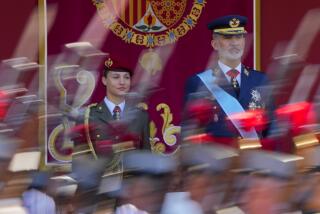A Royal Wedding Boosts Spain’s Spirits
- Share via
MADRID — The future king of Spain, one of Europe’s most coveted royal bachelors, married a TV anchorwoman Saturday in a lavish ceremony that gave this country something to celebrate two months after the deadliest terrorist attacks in its history.
Before 1,700 guests, including 30 heads of state, Crown Prince Felipe exchanged vows and gold rings with commoner Letizia Ortiz, a Spanish-born divorcee whom he met a year and a half ago at a dinner party.
Security was tight, with about 20,000 police deployed throughout the city, airspace closed and borders restricted. An AWACS surveillance plane flew overhead. No violence was reported.
Despite a thunderstorm that dumped torrents of rain on the Spanish capital, thousands of well-wishers lined city streets, freshly planted with a million geraniums, roses and petunias, to catch a glimpse of the royal couple. The rain let up in time for the couple’s armored black Rolls-Royce to travel from the ceremony at Nuestra Senora de la Almudena Cathedral to the palace, where a 6-foot wedding cake and 1,000 bottles of cava -- Spanish sparkling wine -- awaited.
Part of the celebration was muted in honor of the victims of the March 11 railway bombings that killed nearly 200 people: The bachelor party and bridal shower were canceled, as was a traditional post-wedding dance. The wedding Mass was dedicated to the memory of the victims.
Princess Letizia of Asturias, as she is now known, is the first commoner in line to become queen of Spain. The last century has seen an increasing number of monarchs-in-waiting go outside royalty to find their spouses. This month, Denmark’s Crown Prince Frederik wed Mary Donaldson, an Australian businesswoman.
Thanks to constitutional reform enacted by Spain’s new Socialist government, the first child born to Felipe and Letizia, male or female, will become heir to the throne after Felipe. Previously, only males could inherit the crown.
Guests Saturday included Britain’s Prince Charles, former South African President Nelson Mandela, Japan’s Crown Prince Naruhito and Jordan’s Queen Rania. More than 1 billion people were believed to have watched a live television broadcast of the event.
Letizia, 31, comes from a middle-class family. In Saturday’s ceremony, she wore an off-white silk gown by Spanish designer Manuel Pertegaz, with a tight-fitting bodice, long sleeves, an upturned collar, veil and 15-foot train. She also wore a diamond and platinum tiara that Queen Sofia had worn at her 1962 marriage to King Juan Carlos I in Athens.
Felipe, 36, who stands a good foot taller than his bride, wore a navy-blue army uniform with a light blue sash and an array of medals.
It was Spain’s first royal wedding in 98 years. Previous monarchs -- Felipe’s father, Juan Carlos, and grandfather, Juan de Borbon -- married abroad.
At the last royal wedding, in 1906, an anarchist hurled a bomb disguised as a bouquet into the crowd, killing two dozen people.
In the weeks leading up to the wedding, Spaniards were captivated by every detail. Newspapers reported on Ortiz’s dress fittings, the wines chosen for the bridal dinner and gossip on whether the future queen was getting along with her in-laws.
Her past love life also was a matter of discussion. Because her earlier marriage was a civil ceremony, the Roman Catholic Church could overlook the divorce and permit her union with Felipe.
Although a number of Spaniards oppose the monarchy as an obsolete institution, Juan Carlos and his family are generally popular. The king played a key role in Spain’s transition to democracy after the dictatorship of Gen. Francisco Franco and has given the nation a sense of continuity at the margins of whichever political party is in charge. The royal family further endeared itself to the Spanish people by mourning openly and emotionally after the March bombings.
There was a small demonstration Saturday by anti-monarchists, but overall, Spain celebrated the marriage with joy.
“This gives a very modern air to the monarchy,” said an approving Nuria Gutierrez, a shopkeeper. “They were always intelligent, but too serious. Letizia is a woman who knows the people.... Now the important thing is for them to have children.”
“We’ve been through a tragedy,” said Pilar Silverio, a 46-year-old nurse, standing near the Atocha train station, hardest hit by the bomb blasts. “All Spaniards deserve a bit of happiness now.”
*
Times staff writer Tracy Wilkinson in Rome contributed to this report.
More to Read
Sign up for Essential California
The most important California stories and recommendations in your inbox every morning.
You may occasionally receive promotional content from the Los Angeles Times.










